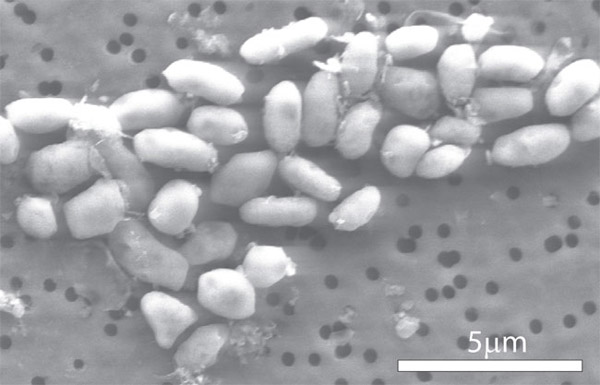Microbe that Eats Arsenic Found

Arsenic may be deadly to us, but now a microbe that can live and grow entirely off the poison has been discovered.
These findings not only show just how tough life can be on Earth, but expand the search for where life might be possible on alien worlds.
Arsenic is normally highly toxic, because it disrupts key metabolic pathways such as those linked with respiration in the body. Still, chemically arsenic behaves quite similarly to phosphorus, one of the six key elements that help make up life on Earth, along with carbon, oxygen, hydrogen, nitrogen and sulfur.
"Arsenic is toxic mainly because its chemical behavior is so similar to that of phosphorus," said researcher Ariel Anbar, a biogeochemist and astrobiologist at Arizona State University. "As a result, organisms have a hard time telling these elements apart. But arsenic is different enough that it doesn't work as well as phosphorus, so it gets in there and sort of gums up the works of our biochemical machinery."
Scientists had found microbes capable of chemically processing arsenic in Bangladesh. The newly discovered bacterium goes a step further in that it can completely swap arsenic for phosphorus, even incorporating the toxin into its DNA. [Graphic showing how it works]
"Our findings are a reminder that life-as-we-know-it could be much more flexible than we generally assume or can imagine," said researcher Felisa Wolfe-Simon, a geomicrobiologist at NASA's Astrobiology Institute and the U.S. Geological Survey at Menlo Park, Calif. "If something here on Earth can do something so unexpected, what else can life do that we haven't seen yet? Now is the time to find out." [Microbe that Thrives on Arsenic Opens Up New Possibilities for Alien Life]
The microbe, named strain GFAJ-1, is a salt-loving member of the Halomonadaceae family of proteobacteria that came from the sediments of toxic Mono Lake in eastern California. This old alkaline lake is known for its being hyper-salty and naturally high in arsenic.
Sign up for the Live Science daily newsletter now
Get the world’s most fascinating discoveries delivered straight to your inbox.
In the lab, Wolfe-Simon and her colleagues grew the bacterium in petri dishes, gradually replacing phosphate salts with arsenic until it could live without phosphorus, an essential construction block of molecules present in all cells, including proteins and cell membranes. Using radioactive isotopes of arsenic, the researchers followed the path arsenic took in the bacteria. They saw that it completely replaced phosphorus in the bacterial cells, right down to the organism's DNA.
"This organism has dual capability," said researcher Paul Davies, a cosmologist, astrobiologist and theoretical physicist at Arizona State University. "It can grow with either phosphorous or arsenic. That makes it very peculiar, though it falls short of being some form of truly 'alien' life belonging to a different tree of life with a separate origin. However, GFAJ-1 may be a pointer to even weirder organisms. The holy grail would be a microbe that contained no phosphorus at all."
Next, Wolfe-Simon and her colleagues want to collect samples from places with high arsenic but low phosphorus concentrations. They hope to find microbes that depend solely on arsenic.
"Life as we know it requires particular chemical elements and excludes others," Anbar said. "But are those the only options? How different could life be?"
Davies predicted that the new microbe "is surely the tip of a big iceberg, and so has the potential to open up a whole new domain of microbiology."
"One of the guiding principles in the search for life on other planets, and of our astrobiology program, is that we should 'follow the elements,'" Anbar said. "Felisa's study teaches us that we ought to think harder about which elements to follow."
The scientists detailed their findings online Dec. 2 in the journal Science.
- Extremophiles: World's Weirdest Life
- Image Gallery: Strangest Alien Planets
- The 10 Most Diabolical and Disgusting Parasites











